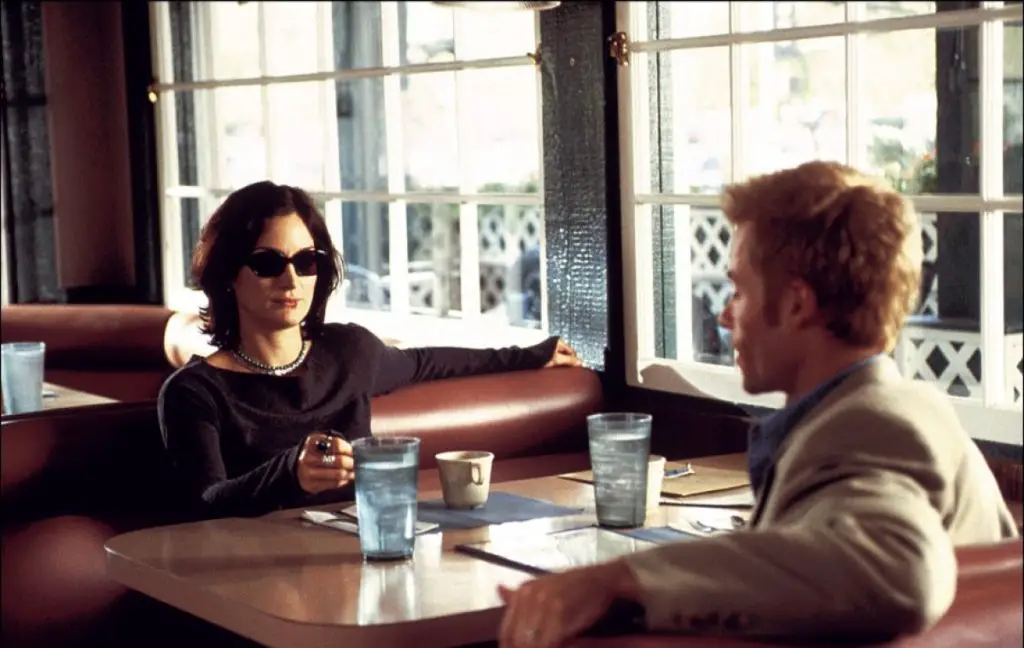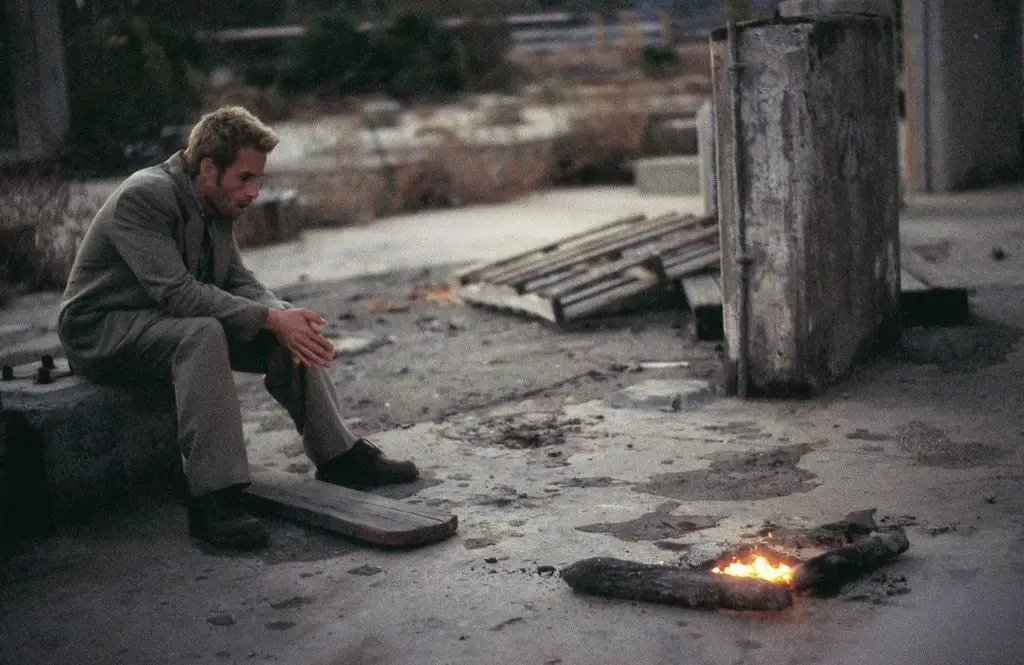“My Own Reality”: What Is The Essence Of The Thriller Memento (2000). The Meaning Of The Film Memento , Plot Analysis, Essence, Explanation Of The Ending, Similar Films.
Genre: Thriller, Detective, Drama, Crime
Year of production: 2000
Director: Christopher Nolan
Actors: Guy Pearce, Carrie-Anne Moss, Joe Pantoliano
Tagline: “Some memories are best forgotten”
Awards and nominations: In 2002, the film was nominated for an Oscar for Best Screenplay and Best Editing.
Memento is the second feature film by Christopher Nolan. He is also the most intricate of all his paintings.
Probably, the meaning of the film Memento lies in the final phrase uttered by the main character. Its essence lies in the fact that a person, trying to fill his life with at least something, often starts chasing false goals and loses himself.
What is the movie about
A brief description of the content of the picture. The plot centers on an insurance investigator named Leonard (Lenny) Shelby. One day, he is assigned to investigate the insured event of Sammy Jenkins – a man who, after the accident, stopped remembering new events. The hero manages to prove that Sammy’s “learning disability” is a mental disorder, and not a consequence of a head injury, and Sammy is denied an insurance payment.
 Guy Pearce played the lead role of Leonardo Shelby. Film frame,
Guy Pearce played the lead role of Leonardo Shelby. Film frame,
After some time, criminals enter Leonard’s house and attack him and his wife. Shelby kills one of them, but the second hits him in the head. As a result of the injury, Leonard develops the same ailment as Sammy Jenkins – anterograde amnesia. That is, he remembers well what happened before the attack, but now his short-term memory is limited to fifteen-minute segments. After that, new memories are completely erased.
Leonard, convinced that his wife died after the attack, decides to find the culprit and punish him. Trying to cope with his illness, the hero develops a whole system – he takes instant pictures, writes notes. The most important facts he tattoos on his body. A clue to the identity of the perpetrator is the tattooed name “John G”.
Soon Leonard meets with a certain Teddy, who offers him his help. However, it turns out that the new assistant, a former police officer, is simply using Shelby for his own purposes.
Ending explanation
In the finale, Teddy contacts Leonard and informs him that he has found the real John G. Shelby arrives at the appointed place – an abandoned building outside the city and mortally wounds the one he takes for the murderer of his wife.
However, he was wrong – Teddy pointed him to a drug dealer who had nothing to do with Leonard’s tragedy. Pinned to the wall, he reveals a terrible secret to him: Shelby’s wife suffered an attack, but died from an overdose of insulin. And the culprit was none other than Leonard himself.
 Carrie-Anne Moss played the role of Natalie. Frame from the film.
Carrie-Anne Moss played the role of Natalie. Frame from the film.
According to Teddy, more than a year ago he helped the hero find the criminal who attacked him and his wife and deal with him. That is, the real John G is no longer alive. However, taking advantage of the fact that Leonard does not remember anything, Teddy decided to use him to solve his own problems. So, on his tip, he had already killed several “John Gs” – that is, people who were not involved in the crime. Shelby discovers an interesting coincidence – Teddy’s real name is John G…
Under the threat of death, Teddy helps Leonard understand the truth – which he seemed to be looking for, but which he was afraid of.
The explanation for the ending goes like this: no John G actually existed. The whole story of Sammy Jenkins, which Shelby tells an unknown interlocutor, is his own past, which he took out of his own life, believing that it all happened to someone else.
The overdose of insulin was due to the fact that Leonard did not remember whether he had injected his wife. When he realizes this, his consciousness is clouded, after which he ends up in the hospital. There, his mind begins to rewrite memories – this allows him to cope with what happened. Recall what he said about Sammy’s case: “his case is mental, not physical.” This means that he can create memories and “transfers” events to Jenkins, a con man who feigned memory loss to get money from an insurance company.
In the memoirs of Leonard, he is not the culprit in the death of his wife, but one of the criminals. So he creates a new reality for himself …
After creating a new past for herself, Shelby goes to the police and stumbles upon a corrupt cop, Teddy. He helps him find one of the criminals and kill him. And so begins his pursuit of the ghost.
The meaning of the ending of the movie Memento is in Leonard’s phrase, which sounds like this: “I must believe that my actions matter.” Subconsciously, the hero realizes that he managed to lose himself: having made completely unnecessary revenge the meaning of his life, he wasted it.
The meaning of the film
The film Memento plunges a person into a world in which there is neither past nor future. There is only the real here.
Nolan’s painting tells the story of a man investigating the murder of his wife. However, he has big memory problems. This is not amnesia: Leonard knows who he is, but after the injury, he stopped remembering events.
The film allows you to experience the loss of short-term memory together with the hero. This allows the director to convey to the viewer the feeling of being unable to remember. Nolan tells the story backwards, constantly withholding information from us that is not available to the main character. The picture is constructed in such a way that we find ourselves “in the shoes” of the character: like that, the viewer is disoriented and delves into the essence of what is happening in the course of events.
Leonard suffers from memory loss. He talks to people he doesn’t know, finds himself in unfamiliar places, and the director wanted the audience to feel that too. It is for this reason that the whole story is structured in reverse order. Scene “C” is followed by scene “B”, and after that – scene “A”. That is, first we learn the end of the film and gradually move to the beginning.
The movie Memento asks a lot of questions, and all the color scenes go backwards, reflecting Leonard’s subjective view of the world. We see important details for him (tattoos, pictures, records) in the first person – this is his subjective reality, which is transmitted to us.
 The role of Teddy was played by Joe Pantoliano. Frame from the film.
The role of Teddy was played by Joe Pantoliano. Frame from the film.
We have the information that Leonard has. That is, we, like him, have no idea how we ended up in a particular place, and where we were before. We only know what the photographs and records say – Leonard’s external memory. Unlike many other films, each mise-en-scene here involves the question “What happened before”, and not at all “What will happen next.” At the end of each such mise-en-scene, we get the answer to the previous question.
So that such a somewhat chaotic structure of the picture does not tire the viewer, the director came up with an interesting “chip” – here he alternates color scenes with black and white. The point of black-and-white scenes is that they go chronologically. In them, Leonard tells the story of Sammy Jenkins, a man with similar problems. We keep coming back to Sammy’s story like it’s familiar. It serves as a framework that keeps the story from falling apart and becoming a set of meaningless scenes. Without them, it would be difficult to understand the protagonist’s arc – as, indeed, the essence of the film.
In his investigation, Leonard is forced to rely only on his own notes. The whole problem of the system he created is that the information that he writes on photographs is transmitted to him by people. He has to trust them, hope they don’t lie to him. This is where the main problem lies: sometimes the information written on his photographs is wrong, but he has no idea about it. Various people use his condition throughout the film, and he also does not learn about it right away.
The key to Leonard’s blind trust in these “facts” is that he considers them more reliable than his own memory – because it does not record events, but only interprets them. In reality, Shelby is on the wrong track from the start. It turns out that all the facts he collected are distorted. They are constantly refuted and viewed from a different angle. They are extremely unreliable, since they are the same interpretation of reality as memories.
 Frame from the film.
Frame from the film.
In their analysis of the film Memento viewers note that Leonard’s information storage system finally collapses at the very end, because he slips false facts on himself. That is, Leonard’s long-term memories do not reflect reality – they are created by him. So everything that happens is distorted by his own decisions.
Leonard claims that he lives only for revenge (which becomes a fixed idea for him), and when he kills the man he was hunting, he realizes that his life has become empty. This is what he fears more than anything. It is important for him that all his actions make sense. Basically, he eliminates the “John Gs” in order to continue playing his game. It is not known how many he has already killed, and how many more he will kill … The main character of the film Memento does not need revenge, but the meaning of life – an elusive bandit, for whom he will hunt forever.
Leonard constantly switches to fictional memories. He does not want to believe in what happened to him and replaces real memories with those that suit him more.
Leonard is a lost man. He plays detective and punisher at the same time. As he rides through the cities and kills people, he comes to the following thought: “We all need memories to know who we are.” This is the key phrase of the Nolan film, which contains a hidden meaning: it is impossible to escape from yourself – you must learn to take responsibility for all your actions.
One day Leonard says, “If I close my eyes, the world doesn’t disappear.” This phrase can be interpreted as his relation to the present. Contrary to his “closing his eyes” and the substitution of his memories, the real state of affairs does not disappear …
 Frame from the film.
Frame from the film.
Similar films
Here are a few pictures similar in meaning to Christopher Nolan’s Memento:
- “Before I fall asleep” (UK, USA, France, Sweden, 2014). The main character suffers from a memory disorder: every morning she cannot remember what the last 20 years of her life were filled with;
- “Inside my memory” (UK, USA, 2003). The main character is accused of a car accident in which his brother died. The hero does not remember anything, but one day he realizes that he is able to change the future;
- “The Fall” (USA, 2012). The main character is accused of killing her best friend. A girl suffering from a memory disorder begins her investigation.
- Inception (USA, 2010). Another confusing Nolan film.







